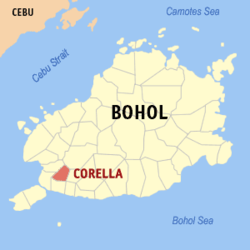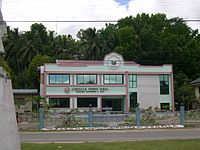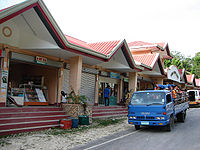- Corella, Bohol
-
Corella — Municipality — Map of Bohol showing the location of Corella Location in the Philippines Country  Philippines
PhilippinesRegion Central Visayas Province  Bohol
BoholDistrict 1st district of Bohol Founded December 3, 1879 Barangays 11 Area - Total 28.93 km2 (11.2 sq mi) Population (2007) - Total 7,471 - Density 258.2/km2 (668.8/sq mi) Time zone PST (UTC+8) ZIP code Income class 6th class Corella is a 6th class municipality in the province of Bohol, Philippines. According to the 2007 census, it has a population of 7,471 people. It is located 10 kilometers north of the provincial capital, Tagbilaran City. It was named after a town in the province of Navarre in Northern Spain.
Corella is known primarily as the home of the endemic Philippine Tarsier, the world's smallest primates. The 7.4 hectare Philippine Tarsier sanctuary run by the Philippine Tarsier Foundation, as well as the Research and Development Center is in Barangay Cancatac (Canapnapan?) of Corella, about three kilometers from the town proper.
The people of Corella are predominantly conservative Roman Catholics who belong to the Parish of Our Lady of the Village (Latin: Nuestra Señora del Villar) whose feast is celebrated on April 27, only four days before the Feast of St. Joseph, the patron saint of Tagbilaran City celebrated on May 1.
Corella does not have any major industry. It boasts of abundant water supply underneath its territory, benefitting mostly the residents of Tagbilaran City with the infrastructure design catering more for the city. As such, it is the town that has become indebted to the government-owned but privately run water distributor for its water consumption.
Corella
Native Name: Nugas Kms. From Tagbilaran: 8 Date Created: December 3, 1879 Pop. (1990) : 6,150 Barangays: 8 Pat. Saint: Nuestra Señora del Villar Rep. District: 1st District Fiesta: April 27
BARANGAYS/ BARANGAY CAPTAINS
Narciso Banal Sr. – Poblacion Patricio Malayao- Pondol Esteban B. Jawa – Anislag Martin P. Salisid - Sambog Adelaida L. Sayon – Canapnapan Cristuto T. Rilay Sr. – Tanday Faustino L. Ejera – Cancatac Bonifacio Malanog – Canaupcaan
Its former name was Nugas before it obtained its present name, Corella. It was then a barrio of Baclayon. The adoption of the name Corella was made at the behest of Fray Jose Maria Cañabas, then the parish priest of Baclayon and endorsed by Fray Felix Gullen, the first Spanish priest. Corella was a name of a village in Navarra, Spain where this town’ patroness, Nuestra Señora del Villar showered miracles.
The creation of this town was due to the untiring efforts of its inhabitants notably Pedro Lumain, Severo Laoay, Lorenzo Darunday Pablo Sayon, Calixto Vale and Isidoro Ramo. The last became its first gobernadorcillo.
The stone church and the convent were constructed during the tenure of Fray Felix Gullen and completed by later priests, one of them being Fray Dionisio Llorete who also spearheaded the erection of two stone school building and the municipal building during the term of the gobernadorcillo, Celedonio Sayon. But the construction of Corella’s present concrete church has begun in 1924 under Fr. Pedro Montelbon, the Parish priest of Tagbilaran who took over the administration of the Corella parish after the incumbent, Fr. Eugenio Desamparados left.
The battle of principles, rights, obligations, and duties raged in the municipality in 1920 between Simeon Sambola, the Parish priest and the municipal president Nicanor C. Tocmo who were at loggerheads on the matter of school administration. From the pulpit, Fray Simeon lambasted the municipal administration and condemned the teachings in Corella schools as having originated from the mouth of hell. Enrollment in the school greatly diminished. Only close family friends and relatives of president Tocmo sent their children to school. The local civil administration complained to the provincial and national authorities. After the fact-finding investigation by the Department of Public Instruction whose report was submitted to the Governor-General, the later caused the removal of Fray Simeon.
During the Japanese occupation, the distance of half way from Corella to Gaboc was a “no-man’s land”. Seized by the Japanese were civilians like Victor Salang and his daughter, Maria Salang, Matias Manlangit, Basilio Sahidsahid and Gregorio Rebuta. All of them were killed on the spot. Honorio Butawan, a bolo volunteer, was caught by the enemy, brought to Tagbilaran never to return. Other civilians of Corella who suffered instant death from the Japanese as they tried to escape from the US army of liberation were Liberato Rosales, Maria (Benang) Daquipa, and Victoria Recaido.
In October 1944, Capt. Martin Maliwanag, a guerilla leader under Major Ismael Ingeniero established his headquarters in Corella, making the convent as his command post and the primary school building east of the town plaza as his detention cell. Several Filipino JCs (Japanese Constabulary) surrendered voluntarily. The first to surrender on October 29, 1944 was Lt. Victorio Sumodabila. He was shot on the spot by Capt. Maliwanag. Four other JCs from Corella who were killed and buried in common grave of Corella were Dandong Lamayo, his brother Fermin Lamayo, Felicisimo Guscal, and his brother-in-law, Celistino Formentera. In all, there were nine Filipino JCs who met their violent deaths in Corella on orders of Capt. Maliwanag. Capt. Maliwanag, by the way, also met his death when he attacked the Japanese garrison in Gaboc, Tagbilaran. His body was buried in the same cemetery where his victims where laid to rest. It was Maliwanag’s men who captured the puppet Japanese governor Agapito Hontanosas.
During the guerilla period, Corella had four mayors closely succeeding each other. The Commonwealth elected mayor, who was suspected to be a Japanese puppet, Catalino C. Vale who was brought to Behind the Clouds, Roman Tocmo who was named acting vice mayor by the guerillas and Tiburcio Aranas who was the acting mayor. After Aranas’s death, Jose Clarin replaced him. When Clarin went on leave, he was substituted by Isaac Filo.
The first municipal captain of Corella was Isidoro Ramo, who was followed by tan Insoy (Lorenzo Tocmo), tan Onsot (Celedonio Sayon), tan Eboy ( Eusebio Galio), tan Ayong (Leocadioo Mahinay), tan Cario(Macario Sinajon), and tan Teo(Mateo Lumain). Under the US administration, the following were elected as municipal presidents: Pedro Togonon, Severino Clarin, 8 yrs. ; Nicanor C. Tocmo, 2 terms; Tomas Lumain, died in office; Lino Añong succeeding Lumain; Nicanor Tocmo, back to office, 1928–1932; Catalino C. Vale, 3 terms, 1933 till war’s outbreak (and became a puppet mayor)
A great majority of the people of the town are engaged in small scale home industries. From 1990, a mark of decrease in population is noted which can be attributed to the spirit of adventurism. This is due to the fact that the land area is small and may not be enough to answer the people’s needs. Groups of people found their way to other parts of the country. Many went to Mindanao in search for greener pastures. Finally, they landed in the place they are searching for. It became the new municipality, now bearing the name “New Corella”.
The spirit of adventurism still pervades in every Corellahanos and as surely as the sun will rise in the east, so surely will there be other new Corellas, sometime, somewhere.
Barangays
Corella is politically subdivided into 8 barangays.
- Anislag
- Canangca-an
- Canapnapan
- Cancatac
- Pandol
- Poblacion
- Sambog
- Tanday
References
External links
- Municipality of Corella
- Philippine Standard Geographic Code
- 2000 Philippine Census Information
- 2007 Philippine Census Information

Cortes Balilihan 

Sikatuna  Corella
Corella 

Tagbilaran Baclayon Alburquerque Municipalities Alburquerque • Alicia • Anda • Antequera • Baclayon • Balilihan • Batuan • Bien Unido • Bilar • Buenavista • Calape • Candijay • Carmen • Catigbian • Clarin • Corella • Cortes • Dagohoy • Danao • Dauis • Dimiao • Duero • Garcia Hernandez • Getafe • Guindulman • Inabanga • Jagna • Lila • Loay • Loboc • Loon • Mabini • Maribojoc • Panglao • Pilar • President Carlos P. Garcia • Sagbayan • San Isidro • San Miguel • Sevilla • Sierra Bullones • Sikatuna • Talibon • Trinidad • Tubigon • Ubay • ValenciaComponent city Categories:- Municipalities of Bohol
Wikimedia Foundation. 2010.





